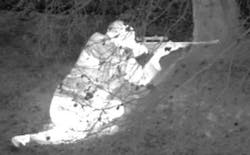Army looks to Teledyne Scientific to refine infrared focal plane array night-vision technology
FORT BELVOIR, Va., 28 Feb. 2014. U.S. Army night-vision researchers are moving forward with a program to refine and demonstrate superlattice infrared focal plane arrays (IRFPAs) for high-resolution military thermal imaging.
Officials of the Army Contracting Command Aberdeen Proving Ground-Belvoir Division at Fort Belvoir, Va., announced their intention this week to negotiate a sole-source contract to Teledyne Scientific & Imaging LLC in Thousand Oaks, Calif., for the second phase of the Vital Infrared Sensor Technology Acceleration (VISTA) program.
In this VISTA phase 2 program, called Dual Band Development and Beyond (DBDB), Teledyne Scientific electro-optics scientists will finish developing and improve the producibility of antimony-based III-V FPAs. The value of the contract has not yet been determined.
Teledyne Scientific will optimize detector design with increased quantum efficiency (QE) and decreased dark current density. The Army Contracting Command is negotiating with Teledyne Scientific on behalf of the Army Night Vision & Electronic Sensors Directorate (NVESD) at Fort Belvoir.
Teledyne Scientific will receive a 21-month contract sole source because Army officials say the company is the only responsible source able to carry out this research. Contract award is expected by April.
The Army VISTA program is working on innovative approaches for infrared FPA technology to enhance infrared sensor capabilities. VISTA's focus is in III-V epitaxial materials research such as superlattice (SL) and NbN structures for advanced infrared FPAs with large-formats and reduced pixel size that are capable of midwave infrared and longwave infrared (MWIR/LWIR) detection.
The program also is investigating analog and all digital-in-the-pixel approaches for advanced read-out integrated circuits (ROICs), which are necessary to demonstrate large-format reduced-pixel-size infrared FPAs.
The Army in late January also announced plans to award a VISTA phase-2 contract to Raytheon Vision Systems (RVS) in Goleta, Calif. Raytheon will refine and demonstrate high-performance infrared FPA technologies that are capable of mid-wave infrared (MWIR), long-wave infrared (LWIR), and LWIR/dual-band detection.
For more information contact Teledyne Scientific & Imaging online at www.teledyne-si.com, Raytheon Vision Systems at www.raytheon.com/capabilities/products/spacesensors, or the Army Night Vision & Electronic Sensors Directorate at www.nvl.army.mil.

John Keller | Editor
John Keller is editor-in-chief of Military & Aerospace Electronics magazine, which provides extensive coverage and analysis of enabling electronic and optoelectronic technologies in military, space, and commercial aviation applications. A member of the Military & Aerospace Electronics staff since the magazine's founding in 1989, Mr. Keller took over as chief editor in 1995.

